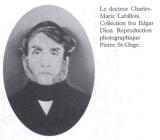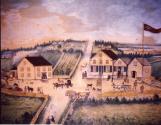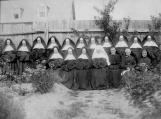6
Charles Marie Labillois, 1793-1868. The forgotten doctorCharles Marie Labillois was born in Ploërmel in the Morbihan in Brittany, July 8th, 1793. He settled in Saint Joseph de Carleton, Quebec, for unknown reasons in 1816. He married Amélie Meagher on October 4th of the same year. They had eleven children together.
Labillois was the resident doctor at the lazaretto in Tracadie from September to December in 1849. He returned from July until the end of December in 1850. He was never paid for his services. The treatments he administered to the lepers during his stay at the lazaretto were nevertheless effective. As stated by the secretary of the Bureau of Health: "All the lepers concur that their health is better and seem quite happy".
No other doctor had given of himself as much as Dr. Labillois to care for le lepers since the opening of the first lazaretto on Sheldrake Island. No doctor had deserved as much respect and affection from the sick and their families. He treated the lepers risking his own life and health. He received from the French government the medal of Sainte Hélène which had been created by the emperor Napoléon 111 in 1857.
Dr. Labillois died at the age of 76 on September 16th, 1868. He is buried in Saint Joseph de Carlton's parish cemetery in Quebec, Gaspé Peninsula.
8
Robert Gordon, doctor, 1799-1863Doctor Robert Gordon was born of Scottish parents in 1799. He practiced medicine in Bathurst. He was named a member of the County's medical commission to investigate the "disease" that was rampant in the region of Tracadie. He was also responsible for visiting Tracadie's lazaretto which he did a few times a year from 1851 to 1863.
He became a member of the Legislative Assembly of New Brunswick in 1850.
He died in Fredericton in 1863 and is buried in Bathurst.
The lazaretto at the time of doctor Gordon's visits. This painting shows the lazaretto surrended by a fence.
9
Doctor Nicholson James, first specialist doctor in the lazaretto1863
Tracadie, New Brunswick, Canada

10
James Nicholson, doctor, 1834-1865Doctor Nicholson settled in Bathurst in 1856 after having studied at New York University. He arrived in Tracadie as a specialist on May 3rd, 1863. He would be the first resident physician. He believed leprosy to be hereditary and not contagious. He went so far as to inoculate himself with the disease to prove his theory. Dr. Nicholson's presence bought some relief and order among the lepers. He organized outdoor games and exercises to reduce boredom. He subsequently made arrangements to procure a boat for them for fishing and navigating.
He died of phtisis at 31 years of age on April 11th, 1865.He is buried in Chatham's St. Andrew's Church cemetery.
Dom Felix Lajat said of Dr. Nicholson that:"He left a reputation as a devoted man much appreciated by the lepers".
11
Doctor Alfred Corbett Smith, first resident doctor at Tracadie1865
Tracadie, New Brunswick, Canada

12
Alfred Corbett Smith, doctor, 1841-1909Son of James Smith and Suzanne M. Dunn of Bathurst, Albert Corbett was born June 7th, 1841. He married Helen Young, daughter of James Young and Ann Ferguson of Tracadie, May 2nd, 1866. He practiced medicine in Newcastle before being named in charge of the lazaretto in 1965. He had a general practice in Tracadie, an area where he would be the only doctor in a 50 miles radius.
There always was a certain distance between Dr. Smith and the French population in which he worked. Firstly, he was not Catholic and secondly, he was English. It seems that despite this, Tracadie's population remembers him warmly as a very nice man. He was known to diagnose poor people and treat them free of charge. He even paid out of pocket, on occasion, for certain medications. He recognized, like doctors of his time, that leprosy was incurable. He was not interested at that moment in finding a remedy. He seeked to alleviate rather its symptoms. His work was greatly appreciated. He made life easier for his patients. He removed all the bars from the windows. He stayed on until his death in 1909.
Dr. Smith was identified with the hospitallers of Tracadie's work until his death on March 12th, 1909 at 68 years of age. He is buried in the Protestants' cemetery in Tracadie
14
Federal Provincial agreementDoctor Jean Charles Taché visited Tracadie's lazaretto in 1872. He conducted an interesting study of the disease.
He proposed the transfer of administrative responsability of the lazaretto from the provincial to the federal government to facilitate financial aid. Steps were taken and came into effect by the signature of the agreement in presence of the Honourable P. Landry, Minister of Public Works, of father A. Babineau in the name of the Minister of the federal government and of mother Brault and her Council on November 25th, 1880 in Tracadie.
15
Joseph Charles Taché, 1820-1894Doctor, politician, journalist, public servant and writer, Joseph Charles Taché, son of Charles Taché, trader, and Louise Henriette de Labroquerie was born December 24th, 1820 in the parish of St. Louis in Kamouraska, Lower Canada. He married Françoise Lepage July 1st, 1847 in Rimouski. They had 6 children. He was elected, without opposition, deputy of Rimouski in the Legislative Assembly of Lower Canada on January 24th, 1848 at the age of 27.
He retired as a deputy in December of 1856. Taché had been chosen shortly before to lead a new daily newspaper:the "Courrier du Canada". Taché's employment at the paper ended in October 1859. He took on a few days later the function of inspector of Canada's asylums and prisons. He was then named in August 1864, as deputy minister of Agriculture and Statistics , an important department that also included public health. This would be his last and his longest career as a high ranking civil servant for 24 years. His most remarkable achievement during this period was the census of 1871 for which he determined its content, form and procedure.
He conceived the desire to study leprosy. He wrote to Mr A. K.
McDougall, Provincial Secretary for the government of Fredericton in 1872. Taché expressed his desire to receive authorization to access Tracadie's lazaretto and its archives. From that moment, he never stopped working to better the state of the lepers. Taché judged necessary and urgent to have the lazaretto's jurisdiction transferred over to the federal government since it was under provincial jurisdiction. He worked diligently on this project and succeeded November 25th, 1880.
He lent the nuns the suppport of his influence and the community always held him amongst its main benefactors and best protectors.
17
The Religious Hospitallers of Tracadie in 1893The Religious Hospitallers of Tracadie in circa 1893 in the garden of the community, near the fence of the lazaretto
Here are the names of the nuns, in the garden of the community:
From left to right, 1st row:
Sisters Amanda Sormany, Landry, Vautour, Otar de la Grange(beginner), Miss Vautour(associate), Blanchard(candidate), and Octavie(lay sister),
2nd row:
sisters Marie Bariault, Elisabeth Landry, Louise Légère, LeRoyer(from Arthabaska), Saint Jean de Goto,(superior), Doucet, Maillet, H. Robichaud, Marguerite Marie, Marie des Anges and Hedwidge.




